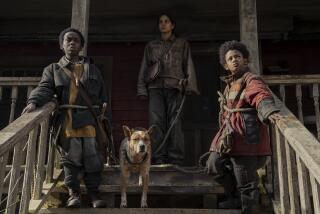The PG-13 thrill ride
Filmmaker Guillermo del Toro’s 8-year-old daughter, Mariana, hasn’t yet been able to see what her dad does all day. “She keeps asking me, ‘When can I see one of your movies?’ ” Del Toro says. Now the director can finally bring her along: For the first time in his five-film career, he’s made a movie that isn’t rated R. “I’ll be happy to buy her a popcorn and sit next to her,” Del Toro says.
Intense dramas and scary horror films usually carry enough carnage to earn the restrictive rating, and the recent box-office charts have been dominated by R-rated bloodbaths such as “Dawn of the Dead” and “The Passion of the Christ.” But a growing number of directors -- such as Del Toro with his new film, next Friday’s “Hellboy” -- are exploring a less gruesome middle ground: the PG-13 thrill ride.
From the recent “Secret Window” to July 30’s “The Village,” an array of filmmakers are trying to shake up moviegoers without resorting to full-volume viscera. Thanks to surprisingly lenient ratings, particularly when it comes to violence, these directors can still display a lot of killing, and despite Del Toro’s decision, young children easily could be traumatized.
These PG-13 movies also are much easier to market, especially on television, and can obviously attract a broader audience than films rated R. Of the 25 movies released last year that grossed more than $100 million, 15 were rated PG-13, while only five were rated R. The PG-13 scary movies are particularly popular with young women: When DreamWorks first tested “The Ring,” the film’s strongest response by far came from girls ages 13 to 18, whom the studio says tend to avoid R-rated violence.
Against a backdrop of pop culture brutality, it’s increasingly difficult to create films that deliver true chills. Unlike violent genre films, these films are much more dependent on execution than executions.
“It’s a great filmmaking challenge,” says producer Barry Josephson, who is making “Hide and Seek,” a Robert De Niro thriller about a motherless child and her imaginary friend, which is designed to get a PG-13 rating. “You don’t have the luxury of lopping off someone’s head.”
For much of the last two decades, Hollywood habitually abandoned scary PG-13 movies. The staple instead became hard-core slasher films like “A Nightmare on Elm Street,” “Scream” and “Halloween.” “People ran away from the form because they didn’t know how to do it,” says Bill Mechanic, the former Fox studio chief who is now producing “Dark Water,” a ghost story starring Jennifer Connelly that is intended to get a PG-13 rating.
While those earlier slasher films may have poked fun at the genre, they took their butchery seriously, and unaccompanied children were prevented from witnessing the mayhem. Even stylish productions, such as the Oscar-winning “The Silence of the Lambs,” were rated R.
Two nearly coincidental events encouraged the studios to reconsider their thinking.
In the summer of 1999, writer-director M. Night Shyamalan’s “The Sixth Sense” scared up more than $293 million at domestic theaters, proving audiences could be riveted more by psychological sophistication than by gross-out garroting. One year later, the Federal Trade Commission cracked down on how Hollywood marketed violent fare, inhibiting studios from selling R-rated movies directly to their most important constituency, young teens.
Over the next several years, a number of PG-13 scary movies turned into big hits, from 2001’s “The Others” to 2002’s “The Ring” and “Signs.” This last film was made by Shyamalan, who also is behind this summer’s “The Village,” about a small town’s relationship with frightening creatures in the surrounding woods. For several filmmakers and studio executives, Shyamalan has become the master of the PG-13 genre. Like Alfred Hitchcock, he delivers chills, positive reviews and lines of ticket buyers. “My blood just ran cold when I saw ‘The Sixth Sense,’ ” says Walter Parkes, co-head of DreamWorks Pictures, which early this summer will begin production on “The Ring 2,” a sequel to its popular thriller about a cursed videotape. “That’s a profound scare, which is so much more effective than a splattering of blood.”
Filmmakers say that very splattering, found not only in violent movies but also in countless video games, has anesthetized moviegoers to shock, making it increasingly difficult to jolt people out of their seats. Directors of PG-13 movies are further tested because they can’t fall back on easy surprises like swinging meat hooks and exploding craniums. The filmmakers essentially have to frighten patrons with one hand tied behind their back.
“It’s like being told to write an article but not to use any adjectives or any words beginning with the letters A, B or C,” says Nick Hamm, director of the April 30 thriller “Godsend,” the story of a couple’s ill-fated cloning of their deceased son. “It’s much more difficult to make these movies.”
In a medium that generally frowns upon subtlety, part of the storytelling solution has been to leave some things unsaid or unseen. “You can scare ... people just by having a camera wander around the house and not know what is going on,” Hamm says. “The expectation of horror is greater sometimes than the reality of horror.”
Parkes says the PG-13 thrillers require more thoughtful scripts and believable acting. “It is not a genre that requires overt violence. And there’s no point in putting more violence in the world than necessary.”
Anyone who watches movies knows that what passes for a PG-13 movie these days likely would have been rated R just a few years ago. Just as soon as the FTC clamped down on marketing R-rated movies, the PG-13 rating almost simultaneously expanded to allow for more violence and even a little more sex, studio executives say.
Even with close-up battle scenes, each of the three “Lord of the Rings” movies was rated PG-13, and despite a barrage of double-entendres, every “Austin Powers” film was as well. Although it too is rated PG-13, “Secret Window” includes a screwdriver jammed into (and extracted from) a human head, then stabbed into a leg.
All the same, when the makers of some of today’s PG-13 movies submit their films for a rating, the Motion Picture Assn. of America’s ratings board seems more concerned about sex than death. Hamm says that while he was obligated to trim a few frames of blood from “Godsend,” it was really a sex scene between actors Greg Kinnear and Rebecca Romijn-Stamos that had to be the most truncated. “You can show extreme violence, but you show one nipple and you’re rated X,” Hamm says.
Quite a few future scary movies, from “Seed of Chucky” to “Blade: Trinity,” will continue to be rated R, as their audience insists that much blood be spilled. But if the subject matter doesn’t demand excessive gore, filmmakers are steering their choices toward the more lenient rating. August 13’s “Alien vs. Predator” could be rated PG-13, even though the films upon which it is based were both rated R.
“From the very start, I wanted ‘Hellboy’ to be a PG-13, because ultimately the heart of the movie and the human side of the movie is sweet, and I wanted it to be a movie that teenagers could watch,” Del Toro says of his adaptation of the Dark Horse comic. “I think PG-13 is a beautiful field to explore atmospheric horror and suspense.”
More to Read
Only good movies
Get the Indie Focus newsletter, Mark Olsen's weekly guide to the world of cinema.
You may occasionally receive promotional content from the Los Angeles Times.











